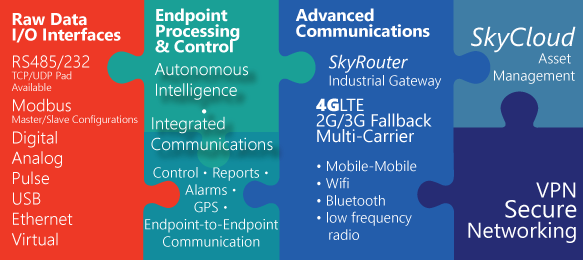DCE Cellular Application Platform
Routine automation projects shouldn’t be as difficult as they are. Nor should they be as time-consuming as they are. And certainly they shouldn’t be as expensive as they are. At least that’s what DCE thinks, and we’ve done something about it.
DCE’s Automation Control application installs on the DCE CDR-LTE. The application combines the logic capabilities of a PLC with the cellular communications capabilities of a DCE CDR-LTE and wraps the entire solution in a point and click rapid development environment. Applications that previously took weeks to develop and deploy can now be in the field and completely online in a day or less. DCE’s Automation Control application is optimized for cellular communications. It differs from traditional SCADA systems in that it does not rely on a central SCADA site to manage the application. Instead DCE’s Automation application relies on distributed intelligence within each endpoint containing all of the control logic required to react to events, issue alarms, and generate reports. Networking logic is provided that allows one DCE Automation endpoint to monitor and manage another in a peer-to-peer networked relationship minimizing the single point of failure risk.
Feature Overview
Automation Control Application
- Analog/Digital/Pulse I/O
- Cellular WAN Communications
- RS485 I/O Module Communications
- Expandable I/O Pin Footprint
- Event (Threshold) Specific Programs
- Multiple Thresholds per Input
- Thresholds on Remote I/O Pins
- Alarms via SMS or email
- Built-in Sensor Calibration
Rapid Development Environment
- Web Based Application Development
- Point and click/drop down interface
- User Defined I/O Names
- User Defined Control Panel
- User Defined CSV Formatted Reports
- Detailed Event Logging
- Multiple SMS/email Destinations
- Supports Custom Event Programs
- XML Interface for remote applications
Key features
Built-in Communications – DCE’s CDR-LTEs provide reliable high-speed IP connections over any
cellular network. The Automation Control application is designed from the ground up to minimize data
usage which allows you to take advantage of low cost telemetry data plans. The same connection can be
used to manage other aspects of an automation projects such as cameras, traffic controllers or to pass
through data from a conventional PLC. The CDR-LTE’s IPsec encryption feature can be applied to the
entire communications subsystem, providing the highest level of data security available.
Versatile I/O – I/O types including digital, analog, pulse, and numeric are available for both physical and
virtual I/O pins. Continuously variable inputs can react to up to fifteen different thresholds and
corresponding hysteresis zones. Alarm repeat and program repeat capabilities for each threshold are
provided.
Function Level Programming – Programs consisting of one or more functions can be constructed from a
function library using web based point-and-click menus. Included functions range in complexity from the
simple ability to set a single output to a sophisticated motor control function that sequences and wear
levels 1 – 4 motors while recording operating hours for each motor controlled.
Virtual Pins – Virtual pins (I/O) provide an extensible mechanism to represent internal values, collect
intermediate results, and implement counter and timer functions. Virtual pins can be connected to
internal CDR-LTE resources such as GPS information, input voltage, system time, and wireless network
status, as well as other physical and virtual inputs and outputs.
Remote Operations – Both physical and virtual I/O pins can be accessed remotely using peer-to-peer
communications. This feature allows applications using two or more geographically separated
CDR-LTEs to be easily constructed.
Logical and Mathematical Operators – Multiple digital inputs can be joined to create additional input
qualification using Boolean operations. Formulas created using standard calculator notation provide a
convenient method of applying additional levels of processing and conditioning to analog, pulse and
numeric inputs.
DCE’s Wireless Automation Control is charting a new course in industrial automation. Instead
of a multiple vendor, multiple box solution for wireless control applications DCE’s solution
combines the communications, automation, and rapid development tools on a single wireless
application platform. Contact us for more information.
Designed and Manufactured in the USA

